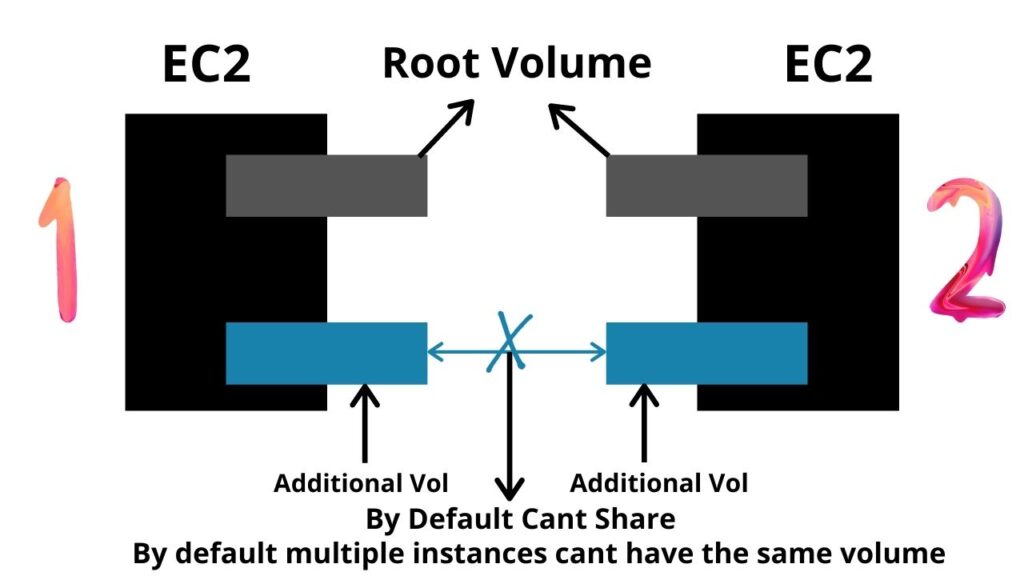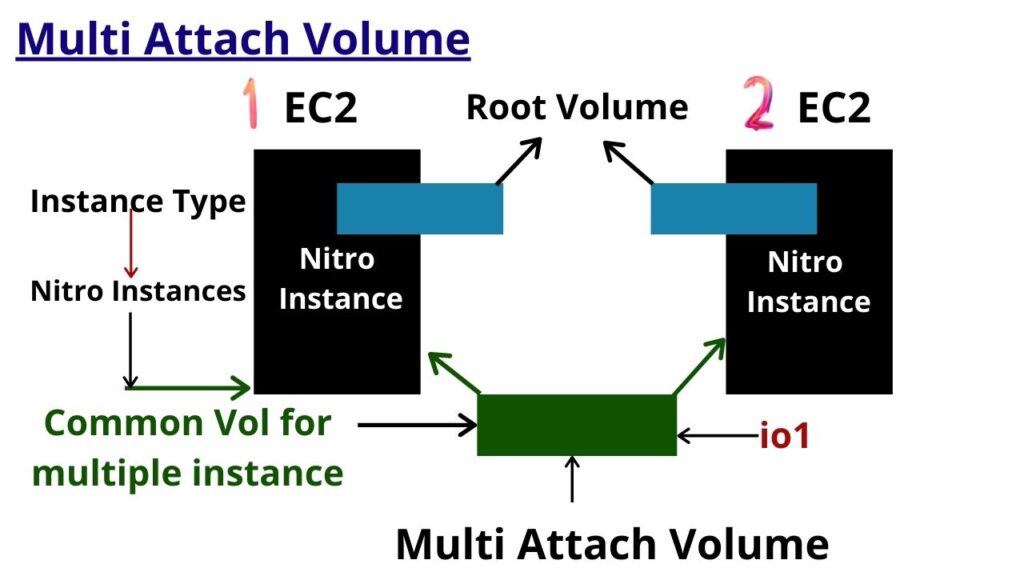Amazon EBS Volumes – what kind of root volumes we have with EC2 instance? Do You Have Some Idea? The Root Volumes With EC2 Instance?
Root Volumes With EC2 Instance
What is a Root Volume? Root Volume Is A Volume Where You Install Or You Launch Your Operating System In EC2.
We Have Two Types Of Root Volumes With EC2 Instance.
-
EC2 Instance Store or Instance Store
-
EBS Volume
1. EC2 Instance Store or Instance Store
Instance Store Provides Temporary Block Level Storage For Your Instance. It Doesn’t Store Your Data. This Is Only To Run Your Machine.
But If You Want To Store Data, If You Want Store Any Configuration, This Instance Store Type Doesn’t Allow.
This Instance Store Type Located On Disk, Physically Attached To Your Host Computer And Instance Store Is Deal For Temporary Storage of an Information.
That Changes Frequently, Such As Buffers, Cache, Scratch Data Or Other Temporary Content.
It Replicates Your Data To The Frate Of Instances. If You Have Bunch Of Instances and You Are Running Under Load Balancer So It Will Replicate Your Data with Multiple Instances.
That Is There But It Does Not Store Your Data Permanently, It Only Stores Temporary, So This Is The Temporary Store, So That’s Why We Are Saying It Is Temporary Block Level Storage For Your Instance.
And It Stores Buffers, Caches, Scratch Data And Other Temporary Content.
This Virtual Devices For Instances Volumes Are Ephemral.And You Can Select From 0-23 For Your EC2 Instance.
And Instance Type Store One Instance Type Volumes, Like Ephemeral Volume 0 then 1, like this maximum 23 Volumes Can Be Connected Of Instance Store Type.
From Where You’ll Get All These Instance Store Because When You Launch Your Instance Offourse You Don’t Get It.
We Have Different Instance Types.
We Have A Specific Instance Store Type Instances, Where You Can Use Instance Store volumes.
For Example :- If You Open AWS, If You Try To Launch A Machine.
Lets Say You Are Taking This Amazon Linux 2 AMI from Quick Category, You Have This Instance Type, Of course t2.micro You Will Take.
And What About Volume, Lets Say Directly Click On Volume, What Kind Of Volume You Have?
You Have EBS Volume, This Is Just Like A RAM. This Is The EBS Volume By Default You Are Getting.
But If You Need Instance Store Volume Type. What You’ll Do At The Time Of The Launch, Click On Community AMI, In Community AMI, Just Click On Amazon Linux, There You’ll Have The Root Device Types.
- EBS
- Instance Store
If You Select Instance Store, You’ll Get Only EC2 Instance Type Instance Store, You Can See.
While Creating Instance On AWS Management Console( 2.Choose Instance Type) – See This Page
- If You Choose Instance Type Like c3.large You’ll Get This Feature
- You’ll Get This Instance Type
- But In Other Instance Types You Wont Get This
- All Others Will Not Support To Your Instance Type Volume
- This Is Only Available In 4 Or 5 Categories a1,c1,c3,c4… Etc Like c3.Large
- I’ll Take c3.large, Of course This Is On Free Of Cost
ON 4) Add Storage Step While Creating An Instance On AWS Management Console Page
- If You See Volume Type, You Have Two Volumes
- Instance Store 0, Instance Store 1
- The Size Of The Volume Is 16 GB
- So These Are Ephemeral, Ephemeral Instance Store Types
- So If You Are Selecting This Type Of Volume Types, What Benefit You’ll Get?
- You Can Install Every time You Start, Every Time The Operating System Will Launch
- And The Configuration Whatever You Have Done, Those Will Not There Again
- Which Means You Have To Configure Them Again
- So If You Start And Stop These Kind Of Instances
- First Of All You Cannot Stop These Instances
- One You Start The Instances, You Cant Stop The Instances.
- And If You Terminate And If You Try To Make Just An AMI It Is Not Possible.
- So We Are Using Such Kind Of Machines Only If You Want To Save Money.
- If You Want To Save Cost.
- If You Are Machines Are Not Important To Save Your Data, In That Case You Can Create Suck Kind Of Machines.
- Which Support Instance Store Volume Types.
- If You Want To Use Your Machines And If You Dont Want To Save Your Data, In That Case You Will Use Instance Store Volume Type.
- Instance Type Store Volume Type Is Cheaper Than EBS Volume Type.
- EBS Volumes Are Expensive
- EBS Backed Instance Volume Type Instance Can Be Stopped, Can Be Start, Can Be Restarted, Can Be Terminated.
- Instance Store Volume Type Only Can Be Rebooted.
- Important Thing Is Instances Either Can Be Terminated or Rebooted
- But You Cannot Stop These Instances
- If You Want Low Price Volume And If You Dont Want To Store Your Data, Then This Instance Store Will Work For You.
- Otherwise It Is Not Required.
- So In What Condition You Can Think About, In What Condition You Should Use This Instance Store.
2. EBS Volume Type
- We Have Three Types Of Volume
- SSD (Solid State Drive)
These Are Optimized For Transactional Work Loads, If You Are Frequently Reading & Writing Data & You Are Seeking Performance On Your EC2 Instances.
Or If You Are Needing The Fast Read, Write Operations On Your EBS Volumes, You Should Always Select SSD Type.
2. HDD
This Is Your Hard Disk Drives The Normally You See.
3. Previous Generation
One More We Have, This Is Called The Previous Generation.
1) SSD Are Two Types :-
1. General Purpose SSD – General Purpose Provides The Balance Price & Performance & We Recommend Such Kind of Volumes With The Most Work Loads, Means If You Are Not Seeking The High Performance Volumes And If Your Volumes Are Generate & If You Are Not Seeking Very High Performance Read, Write Operations On Your EBS Volume Even Though You Are Price Conscious Also In That Case You Should Choose General Purpose, In General Purpose We Have Further Two Types, There Are Two Types
- GP3 –
- GP2-
If We Talk About Durability, Lets Say, Few Things Are There, You Can Measure The Performance Like Durability, You Have Some Use Cases.
Durability – It Provides All Most Approximately, 99.8% Durability, The Same You’ll Find GP2 Is 99.8 Durability.
Use cases(Means Where You Can Use General Purpose Kind Of Volumes) – IF You Are In Low Latency Or If You Are In Development Or Testing Environment, You Can Use In Both gp3 & gp2.
You Can Use Dev/Test Environment Or In Low Latency.
So These Are The Use Cases
Volume – what the minimum volume and maximum volume it will support, It Will Support From 1 GB- 16 TB Per Volume.
Maximum IOPS(Input Output Operations Per Second) – This Is Actually The Mechanism Manage The Speed of EBS Volume. Maximum 16000 IOPS You Can Provide Per Volume.
Maximum Throughput – Maximum Throughput Can Reach In This Case 1000 Mbps For gp3, For gp2 It Can Reach upto 250 Mbps
Multi Attach Feature – It Does Not Support.
Bootable Volume – Yes, You Can Use General Purpose Volumes As The Boot Volume.
These Are Some Features Of General Purpose SSD.
How Many Volumes Can Be Added Maximum?
It Depend On The Instance Type You Are Selecting, By Default In t2.micro Maximum 24 Volumes You Can Take, It Highly Depends On What Kind Of Instance Type You Are Selecting.
What Does It Mean Per Volume?
Volume Means One Hard Disk You Are Connected, Lets Say Im Assuming aEC2 Instance,
EBS Block Storage Volume In It.You Can Start With The One Volume, You Can Select Number Of Volumes On A Same Instance, Volume Size Can Vary Between 1GB to 16 GB, Depend How Much Volume You Are Taking.
If You Are Using Free Tier Eligible, You Cannot Use More Than 30 GB.
Otherwise In Production The Volume Size Can Vary In General Purpose From 1gb-16TB Per Volume.
2. Provisioned IOPS –
It further Have Two Types.1) io2 2) io1
Where Exactly You Can Use Provisioned IOPS?
You Can Use This Provisioned IOPS.
What Are The Use Cases?
1.io2 –
- Durability Is 99.9, Little Better Than General Purpose SSD.
- Use Cases For Provisioned IOPS Are Different.
- I’m Just Taking The Generic One, Where Exactly The Work Load That Requires Milli Second Latency.
- Latency You Are Seeking In Milli Second’s For Production Environment Both.
- These Are High Performance Volumes & Expensive.
- Volume Size Is 4GB-64TB
- Maximum No of IOPS 256000
- Maximum Throughput 4000 Mbps
- Multi Attach Feature Is Not Supported
- Boot Volume It Does Support
2.io1 –
- Durability Is 99.9
- Use Cases For Provisioned IOPS Are Different.
- I’m Just Taking The Generic One, Where Exactly The Work Load That Requires Milli Second Latency.
- Latency You Are Seeking In Milli Second’s For Production Environment Both.
- These Are High Performance Volumes & Expensive.
- Volume Size Is 4GB-16TB
- Maximum IOPS 64000
- 1000 Mbps
- Multi Attach Feature Is Supported
- Boot Volume It Does Support
2)HDD
- In HDD further we Have Two Types.
- Through Put HDD
- Cold HDD
1. Throughput HDD(st 1) –
- 99.8-99.9 % Performance You’ll Have Latency.
- If You Are Dealing With Very Large Amount of Data, If You Are Using Big Data, You Are Using The Machine For The Data ware Housing.
- If You Are Using Machine For Log Processing.
- In Such Cases You Can Use Throughput HDD.
- HDD is Less Expensive As Compare To SDD.
- Volume Size Vary Between 125GB-16 TB.
- Maximum IOPS 500.
- Throughput Is 500 Mbps
- Does not Support Boot Volume, You Cannot Use These Kind Of A Volume, As Your Primary Volume With Your EC2 Instance, You Want To Add Additional Volume, Definitely You Can Use Them These HDD are Not Supported.
2.Cold HDD(sc1) –
- 99.8-99.9 % Performance You’ll Have Latency
- If The Data Is Not Using Very Frequently, You Can Use Cold HDD.
- And Where You Are Seeking Low Latency.
- It Doesn’t Impact Your Project.
- This Is Only For The Storage Purpose, Where You Do Not Seek Performance and Its Low Performance Volume.
- Volume Size Vary Between 125GB-16TB
- Maximum IOPS 250.
- Throughput Is 250 Mbps
- Does Not Support Boot Volume, You Cannot Use These Kind Of A Volume, As Your Primary Volume With Your EC2 Instance But As A Primary Volume As Boot Volume These HDDs Are Not Supported.
3)Previous Generation-
- Previous Generation Volume Basically Is Standard.
- Here You Want To Just Store Your Data, To Only Store Data, Simply With Low Latency.
- Of course If You Are Not Using Your Data Frequently.
- The Volume Size Can Vary Between 1GB-1TB Only.
- Maximum IOPS, This Is Very Low Cost Volume 40-200 IOPS.
- Even The Through Put Is Also Very Low 40-90 Mbps
- It Does Support Boot Volumes.
These Are About Volumes.
Multi Attached Feature Is Only Supported By i01.
Means Lets Say You Have An 2 EC2 Instances.
and Every Instance Will Have 1 Root Volume.
Root Volume, Instances Have Their Own Root Volumes.
Their EBS Volumes Are Different Because Their Operating Systems Are Different.
Their Settings Are Different.
May Be You Are Configuring Machine With Some Different Settings Not Common Basically I Think To On A Same EBS Volume With The Multiple Machines.
Their Root Volumes Are Of course Different.
But If You Have Some Additional Volume In Your Standard EC2 Instances.
If You Have Standard EC2 Instances You’ll Have Additional Volumes.

Of course You Cannot Share That With Other Instances By Default.
Their Volumes Are Different.
Different Machines Have Different Volumes.
So One Volume Cannot Be Attached With Multiple EC2 Instances.
But In Other Case(Special Case) Which Is Known As Multi Attach Volume.
In This Multi Attach Volume, Of course The Instances Have Their Root Volumes.
But I You Are Seeking One Common Volume, That Is Known As Multi Attach Volume.
This Type Should Be i01 Provisioned Iops.
If You Have This Volume & Your Machines Are Specific To The Support.
Such Kind Of Thing, Definitely, You Can Attach The Same Volume With Multiple EC2 Instances.
So This Particular Volume Will Behave Like An Common Volume To These Instances In The Picture Below.

Common Volume For Multiple Instances In The Case You Are Taking i01 Type.
Instances Should Be NitroType.
If You Want To Use io1 & If You Want To Use Multi-Attach Feature With Instances, So The Machines Specification Or Machine Instance Type Should Be Nitro Instances.
Nitro Instances Are Advanced, These Are Supported By Multi Attach Feature.
You Can Check Nitro Instances Type By Searching On Google.
